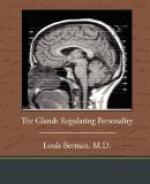There are certain general statements about the teeth and the internal secretions that can be made. The teeth of the thyroid types are pearly, glistening, small and regular; in other words, the teeth to which poets have devoted sonnets. The pituitary types have teeth that are large and square and irregular, with prominence of the middle incisors, and a marked separation or crowding of them. The interstitial types have small irregular upper teeth, with turned, stumpy or missing lateral incisors. The thymus types have youthful, milky white teeth that are thin and translucent, and scalloped or crescentic at the grinding edge. The teeth of the adrenal type are all well-developed, tend to have a yellowish color, with a reddish tinge to the grinding surfaces.
The degree and regularity of development of the middle upper cutting, biting teeth, as distinguished from the grinding molars, the middle and lateral incisors, and the canines offer further guides to the endocrine constitution analysis. The size of the central incisors seems to be directly proportional to the degree of pituitary predominance. On the other hand, the size and regularity of the lateral incisors seem proportional to the influence of the interstitial cells. When these are inferior in the make-up of an individual, the lateral incisors are nearly always distorted. The size of the canines appears to be a measure of adrenal activity. Long sharply pointed canines mean well-functioning adrenal gland equipment to start in with, inherited from a bellicose progenitor.
No individual peculiarities of the teeth are accidental. Just as the absence of hair on the face in a man or a moustache effect in a woman stand for some definite stress or strain in the mechanics of interaction of the internal secretions, so likewise do variations in dentition, as to the time of eruption of the teeth, their position and quality, and their resistance to decay.
Proper balance between the thymus and pituitary will permit the eruption of the teeth within the normal time limits, both the milk teeth and the permanent teeth. When there is equilibrium between the pituitary and the gonads, the teeth will be regular in shape and position. Carious teeth, in children and adults, sometimes indicate endocrine imbalance. Thyroid and adrenal balance determines the resistance to decay of the molars. Early decay of the molars in children is significant of insufficiency of the thyroid. When the first permanent molar, which should appear in the upper arch in its usual position between the sixth or eighth years, does not, there has been a prenatal disturbance of the pituitary, according to Chayes and others. Rapid decay of the teeth in childhood should always call attention to the parathyroids.
In pregnancy, the teeth suffer particularly because of disturbances of the endocrines. The saying, “A tooth for every child,” is said to have its equivalent in every language. The bicuspids and second permanent molars erupt around puberty, when profound readjustments are going on among the glands of internal secretion. They consequently suffer with their abnormalities or divergences from type. The teeth thus furnish a good deal of information concerning the distribution of the balance of power among the hormones.




